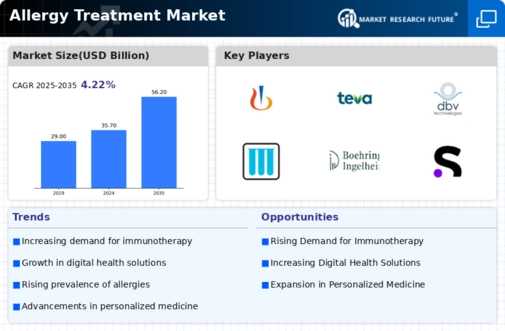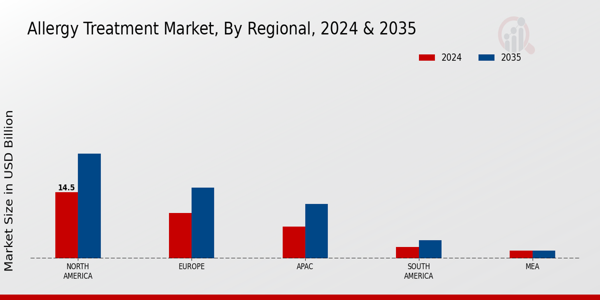Market Growth Projections
The Global Allergy Treatment Market Industry is poised for substantial growth, with projections indicating a market size of 35.7 USD Billion in 2024 and an anticipated increase to 56.2 USD Billion by 2035. This growth trajectory suggests a compound annual growth rate (CAGR) of 4.22% from 2025 to 2035. Factors contributing to this growth include rising allergy prevalence, advancements in treatment options, increased awareness, regulatory support, and rising healthcare expenditure. These elements collectively create a favorable environment for the expansion of the allergy treatment market, highlighting the importance of ongoing innovation and investment in this critical healthcare sector.
Rising Allergy Prevalence
The increasing prevalence of allergies globally is a primary driver of the Global Allergy Treatment Market Industry. Reports indicate that approximately 30 to 40 percent of the global population is affected by allergic conditions, with numbers expected to rise. This surge is attributed to environmental factors, lifestyle changes, and urbanization. As a result, the demand for effective allergy treatments is escalating, contributing to the market's projected growth. The Global Allergy Treatment Market is anticipated to reach 35.7 USD Billion in 2024, reflecting the urgent need for innovative therapeutic solutions to address this growing health concern.
Rising Healthcare Expenditure
The increasing healthcare expenditure globally is a crucial factor influencing the Global Allergy Treatment Market Industry. As countries allocate more resources to healthcare, there is a corresponding rise in spending on allergy treatments and therapies. This trend is particularly evident in developed nations, where healthcare budgets are expanding to accommodate advanced medical technologies and treatments. The commitment to improving health outcomes drives investments in allergy management solutions, thereby supporting market growth. With projections indicating a market size of 56.2 USD Billion by 2035, the upward trajectory of healthcare spending is likely to sustain the demand for effective allergy treatments.
Regulatory Support and Approvals
Regulatory bodies worldwide are increasingly supportive of the development and approval of new allergy treatments, which is a significant driver for the Global Allergy Treatment Market Industry. Streamlined approval processes and incentives for research and development have encouraged pharmaceutical companies to invest in allergy therapies. For example, the U.S. Food and Drug Administration has expedited the review of several novel allergy treatments, facilitating quicker access for patients. This regulatory environment fosters innovation and enhances the availability of effective treatment options. As a result, the market is poised for growth, with a projected value of 35.7 USD Billion in 2024, reflecting the positive impact of regulatory frameworks.
Advancements in Treatment Options
Innovations in allergy treatment methodologies are significantly influencing the Global Allergy Treatment Market Industry. The development of biologics, immunotherapy, and targeted therapies has transformed the landscape of allergy management. For instance, sublingual immunotherapy has gained traction due to its convenience and efficacy. These advancements not only enhance patient compliance but also broaden the range of available treatment options. As the market evolves, the introduction of novel therapies is expected to drive growth, with projections indicating a market size of 56.2 USD Billion by 2035, underscoring the importance of continuous research and development in this sector.
Increased Awareness and Education
Growing awareness regarding allergies and their management is propelling the Global Allergy Treatment Market Industry forward. Educational campaigns by health organizations and governments have played a crucial role in informing the public about allergy symptoms, triggers, and treatment options. This heightened awareness leads to earlier diagnosis and treatment, thereby increasing the demand for allergy medications and therapies. As individuals become more proactive in managing their allergies, the market is likely to experience sustained growth. The anticipated compound annual growth rate (CAGR) of 4.22% from 2025 to 2035 reflects the ongoing commitment to improving allergy care and treatment accessibility.

















